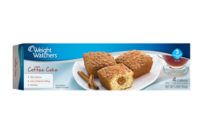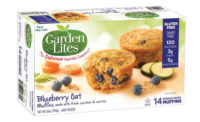It’s no secret that consumers are scrutinizing product labels for nutrients and unhealthy red flags. So it might be tempting to jump to the conclusion that baked sweet goods—including products like doughnuts, Danishes, sweet rolls, coffee cakes and muffins—typically considered an indulgent food category, might be suffering in sales. But that’s not the case.
Overview | Bread | Tortillas | Sweet Goods | Snack Cakes | Pizza | Desserts | Cookies | Buns & Rolls | Bars
Manufacturers of sweet goods continue to see strong sales of traditional products, while also branching out into areas considered “health halos,” like clean-label and portion control. And both segments will continue to push the category forward.
Market data
According to data from IRI, Chicago, total category sales exceeded $3 billion in the 52 weeks ending April 19, 2015, a 4.36 percent increase from the previous year. Doughnuts—today’s cupcake, one might argue—reached $1.25 billion in sales (up 3.6 percent over the previous year), while sales of muffins grew just over 7 percent to reach $635 million. The pastry, Danish and coffee cake segment grew 3.7 percent to reach just under $1.2 billion. The one constant? Across the board, top sellers were private label.
But the primary players in sweet goods continue to rank within the top five companies and brands, including Bimbo Bakeries USA and its Entenmann’s brand, McKee Foods Corp. and Little Debbie, Aryzta LLC and Otis Spunkmeyer muffins, and Hostess Brands LLC and its eponymous doughnut and muffin products. Krispy Kreme also continues to do well with the retail arm of its doughnut business.
One interesting new addition to the center-store coffee cake segment is the Fiber One Cinnamon Coffee Cake product from General Mills, which saw over $78 million in sales over the 52-week period, with a 158.05 percent dollar sales gain. General Mills launched the product, which has 90 calories and 20 percent of the daily value for fiber per serving, in 2013. This success story shows that truly better-for-you sweet goods, with the right branding and formulation tactics, can resonate with shoppers.
Shoppers continue to flock to the in-store bakery, a section of the store with strong connections to the notion of “fresh” baked goods. “The continued growth reflects the consumer trend of desiring ‘fresh’ items from their grocers,” says David Skinner, marketing manager, James Skinner Baking Co., Omaha, NE. “The fresh movement goes hand-in-hand with the bakery, as it is perceived to contain the freshest items available at grocers.”
So while consumers, in some cases, might scrutinize labels more and be more selective when it comes to purchasing sweet goods, their goals don’t necessarily align with the nonfat and sugar-free demands of years past—at least when it comes to affordable indulgences like sweet goods.
Looking back
The truth is that consumer demand for healthier, better quality products is reaching the sweet goods market. However, what healthy shoppers are looking for today is a bit different than what they’ve searched for in the past, says Skinner.
“The health-conscious consumer is a trend that needs the most attention,” says Skinner. “In the age of information transparency, consumers are learning more about what they’re eating. When it comes to the health-conscious consumer, it’s important to distinguish between trends that are a flash in the pan and ones that will have staying power. One subset of this trend that we’ve identified as having staying power is the cleaner ingredient panel.”
According to Alex Peña, director of product development, Pak Group North America, Pasadena, CA, this is good news for artisan-style bakers, who inherently appeal to this trend. “People want to go back to what it was like before preservatives,” he says. “They want that clean label, and they are reading those labels. If they don’t understand what it says, they will put it back on the shelf.” That’s why, he says, smaller bakers that craft their products in smaller batches have developed an edge with such consumers. Since artisan bakers tend to
use recognizable ingredients, they’re clean-label by nature.
That said, consumers understand that a clean label doesn’t necessarily make a product a health food and, as such, bakers are shifting to offer smaller quantities, so that each “splurge” won’t derail an overall healthy diet. “As Americans’ ideas of what’s healthy continue to evolve, we’re noticing that we continue to hear the mantra of ‘moderation is key,’” says Skinner. “They are beginning to understand that a healthy, well-balanced and portion-controlled diet is key, but that diet also includes the occasional indulgence. When this consumer goes to indulge, they want to indulge properly and in the healthiest way possible, and that comes in the form of snacking on smaller, higher-quality products with better ingredients.”
A smaller portion also appeals to shoppers seeking on-the-go, portable options, another trend driving the sweet goods market, and a strong market in foodservice. Convenience store chains like Wawa and Kwik Trip continue to expand foodservice offerings, including a diverse assortment of sweet goods like cinnamon rolls, Danishes, doughnuts and muffins. And Starbucks, through its acquisition of La Boulange, has added more sweet goods to its bakery case—items like a Blueberry Yogurt Muffin with Honey, Almond Croissant Blossom made with almond filling and topped with toasted sliced almonds, and a Morning Bun pastry made with orange zest and cinnamon.
Additional good news for artisan brands is that, while many consumers look to the sweet goods category for their old favorites, more daring flavor trends that previously dominated other food categories are making their way to the bakery aisle. And smaller batches mean more flexibility.
James Skinner Baking Co. has merged both the flavor and portion trends in its new launches. Its Triple Flavor-Fest Ring Danish is a 16-ounce ring-shaped pastry that alternates flavors such as apple, raspberry and cheese, and that consumers can easily pull apart. “The segmented Danishes take the guesswork out of portions,” says Skinner.
The company has also expanded its flavor offerings for its strip Danish to include trendier options like salted caramel and guava. “While a flavor like guava may not resonate with a national audience, the addition of the flavor was a result of the need to cater to regional flavors and trends,” Skinner explains. “Applying this flavor to an item currently in our line-up enables us to stay efficient, yet specialized.”
Large-scale bakers are following suit. General Mills Convenience recently announced a new product, Pillsbury Minis, to appeal to the smaller serving size trend and meet convenience demands along the way. These bite-sized treats, which began shipping in April, come in four varieties: Mini Cinnamon Rolls, Mini Blueberry Muffins with Streusel, Mini Cinnamon Crumb Cake, and Mini Chocolate Chip Muffins.
While small bakers are particularly suited to the clean-label trend, large bakers can also get in on the trend by assessing their lineup and seeking out suppliers that offer alternative ingredients. One place to start might be dough conditioners, says Peña, since they often contain preservatives and can be a barrier to achieving a clean label. “Lots of times, it’s the dough conditioner that’s lending ‘unclean’ ingredients,” he explains. New dough conditioners, he says, are enzyme-based, “so manufacturers can clean up their labels. They lend pliability and freshness without using preservatives that consumers cannot pronounce.”
For many healthy shoppers, though, a clean label isn’t enough—even recognizable ingredients like sugar and flour are off-limits. So other sweet bakery brands are taking the healthy trend a step further by offering inherently good-for-you sweets or options that appeal to specific diets like organic, gluten-free or paleo.
The muffin segment is perhaps better suited to meet these shopper desires than other areas in sweet goods. Muffin Revolution LLC, Berkeley, CA, recently introduced four varieties of its gluten-free, grain-free, high-protein offerings: Banana Bam Bam (banana, blueberry, chia seeds), Yam Good (yam, apple, pecan, flax seeds), The Hulk (coconut, banana, spirulina, yerba mate, hemp seeds) and Cha Cha Cha (cherry, chocolate, chia seeds).
“We feel we’ve tapped into an area of the market that is hungry for healthier alternatives,” says Christy Kovacs, co-owner, Muffin Revolution. “Our demographic doesn’t want to eat refined oils, sugars and flours, and there just aren’t many options out there for them. The nonfat, sugar-free, low-carb era of the last 20 or so years seems to be shifting to a mindset of eating ‘real,’ unadulterated food. Counting calories is becoming less important than focusing on the quality of the foods we eat, and the sweets category should be no exception.”
Better-for-you muffins also work on a large scale. One top-five muffin bakery, Uncle Wally’s—a company founded by Wally Amos, the man behind the Famous Amos cookie brand (currently owned by Kellogg Co.)—specializes in private label baked goods and offers both traditional, indulgent muffins and nutritionally improved and special-diet options like sugar-free and reduced-fat muffins, as well as portion-controlled, snack-sized muffins.
Looking ahead
Demographics will likely factor strongly into the immediate future of the sweet goods category. According to Skinner, the next steps in the market will rely heavily on changing demographics and inherent trends. “Age, nationality, income, general population and influence are all going to present different scenarios moving forward,” he says. “With the future entailing an ongoing individualistic mindset, this will lead to the continuation of the idea of hypercustomized production. That, in turn, may lead to a decrease in products that are characterized as volume sellers.”
At Muffin Revolution, this customization is predicted as taking the shape of gluten-free and paleo, which, says Kevin Roth, business operations manager for the bakery, “are becoming common language in supermarkets. These types of consumers want to enjoy a delicious treat without taking a hit to their health.”
And then there’s doughnuts, a segment of unbridled indulgence that continues to thrive. While the top packaged doughnut manufacturers continue to soldier on with the basics—glazed, chocolate, powdered, cinnamon, etc., both in traditional sizes and mini options—the foodservice market seeks ever-distinct degrees of uniqueness and differentiation. Doughnut giant Dunkin’ Donuts now menus a Croissant Donut, and recent limited-time-offer (LTO) products have included Cheesecake Squares, square doughnuts filled with a cheesecake-type cream, topped with white icing and Oreo cookie crumbles or raspberry candies. Upscale retailers are also growing more adventuresome in their doughnut offerings, such as the Maple Bacon and Caramel Cashew doughnuts offered at the fast-growing grocer Mariano’s Fresh Markets, with units continually added throughout the Chicago area. The retailer also goes a cobranded route, offering doughnuts topped with Froot Loops or Fruity Pebbles—a trend popularized by now-legendary Voodoo Doughnut, which has expanded beyond its original Oregon home into Colorado.
Of course, not every foodservice or niche-retail concept will take hold in dramatic-enough fashion to make a significant impact on the major manufacturers who make the sweet goods category their home, but smaller to medium-sized bakeries with the flexibility to respond to prevailing consumer currents can make incremental gains into the category.
And early planning and flexibility really is the key, says David Moline, sales and marketing manager at Moline Machinery LLC, Duluth, MN. “Like many product categories, the sweet goods category can be cyclical,” he explains. “Finding the right niche can set you apart from the industry and allow for robust growth in good times and sustainable operations during slow times. The key to carving a niche is flexibility and the ability to react quickly to changing market trends.”
Overview | Bread | Tortillas | Sweet Goods | Snack Cakes | Pizza | Desserts | Cookies | Buns & Rolls | Bars

















